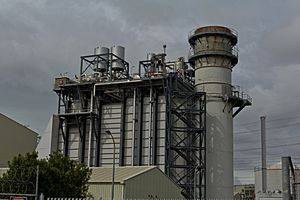Otahuhu Power Station facts for kids
Quick facts for kids Otahuhu Power Station |
|
|---|---|

Otahuhu Power Station's 404 MW combined cycle turbine. Also known as Otahuhu B.
|
|
| Country | New Zealand |
| Location | Otahuhu, Auckland |
| Coordinates | 36°57.072′S 174°51.923′E / 36.951200°S 174.865383°E |
| Status | Operational |
| Commission date | 2000 |
| Decommission date | 2015 |
| Owner(s) | Contact Energy |
The Otahuhu Power Station was a big power plant in Otara, Auckland, New Zealand. It had two main parts, called Otahuhu A and Otahuhu B, which both used natural gas to make electricity. The power station is now closed, but it used to be an important source of power for the area. It was owned by a company called Contact Energy. There was also a plan for a third part, Otahuhu C, but it was never built.
Otahuhu A: The First Power Units
The first power-making machines at Otahuhu started working in 1968. These were called open cycle gas turbines. A gas turbine is like a jet engine that spins a generator to make electricity.
This part of the power station had four units. Each unit could make 45 megawatts (MW) of power. In 1978, two more units were added. These new units used powerful Rolls-Royce Olympus gas turbines.
The Otahuhu A gas turbines stopped making electricity in the late 1990s. However, they still helped keep the national power grid stable. They did this by providing something called "reactive power." This helps manage the flow of electricity. These units were finally shut down completely in November 2013.
Otahuhu B: Modern Power Generation
The Otahuhu B part of the power station started making electricity in January 2000. This section used a more advanced method called "combined cycle." This means it used natural gas to power a gas turbine. The hot exhaust gases from the gas turbine were then used to create steam. This steam powered another turbine, making even more electricity.
This plant used a special Siemens gas turbine. It also had a large heat recovery steam generator (HRSG). The plant used a special cooling tower that mixed wet and dry cooling methods. It used sea water to help with cooling.
When it first opened, Otahuhu B could make 385 MW of power. In 2005, some parts of the plant were updated. This made it even more powerful, able to produce about 404 MW. The Otahuhu B power station stopped making electricity at the end of September 2015.
Otahuhu C: A Power Plant That Was Never Built
Otahuhu C was a plan for another large power station. It was also going to be a 400 MW combined cycle plant. The local council gave permission for the plant to be built in 2001. However, construction never started.
In 2002, a group called the Environmental Defence Society (EDS) challenged the plan. They were worried about the amount of carbon dioxide (CO2) the plant would release. CO2 is a gas that contributes to climate change and the greenhouse effect. EDS suggested that the company should plant new forests to balance out these emissions.
The Environment Court agreed that the CO2 emissions would be a problem. But they decided not to force the company to plant forests. They were not sure if it would be the best or most reasonable solution.
In December 2002, Contact Energy decided to put the building of Otahuhu C on hold. They were worried there might not be enough natural gas available in the future. By 2007, Contact Energy said they were focusing more on making electricity from renewable sources, like geothermal energy. They also wanted to wait for the government to decide on a system for "carbon pricing." This would mean companies would pay for the carbon they release.
Even though it was never built, Otahuhu C was considered a very efficient gas-fired power plant. It could have helped reduce overall emissions if it replaced older, less efficient power stations that used coal.

